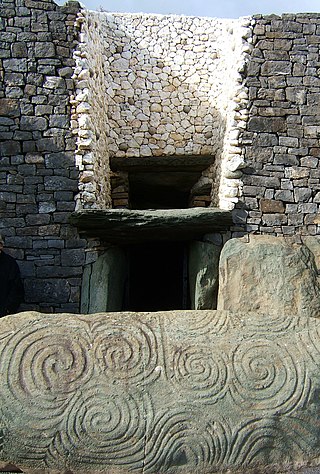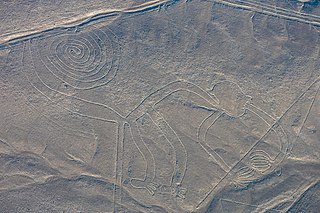Related Research Articles

Archaeoastronomy is the interdisciplinary or multidisciplinary study of how people in the past "have understood the phenomena in the sky, how they used these phenomena and what role the sky played in their cultures". Clive Ruggles argues it is misleading to consider archaeoastronomy to be the study of ancient astronomy, as modern astronomy is a scientific discipline, while archaeoastronomy considers symbolically rich cultural interpretations of phenomena in the sky by other cultures. It is often twinned with ethnoastronomy, the anthropological study of skywatching in contemporary societies. Archaeoastronomy is also closely associated with historical astronomy, the use of historical records of heavenly events to answer astronomical problems and the history of astronomy, which uses written records to evaluate past astronomical practice.

A cave or cavern is a natural void in the ground, specifically a space large enough for a human to enter. Caves often form by the weathering of rock and often extend deep underground. The word cave can refer to smaller openings such as sea caves, rock shelters, and grottos, that extend a relatively short distance into the rock and they are called exogene caves. Caves which extend further underground than the opening is wide are called endogene caves.

Hernando de Soto was a Spanish explorer and conquistador who was involved in expeditions in Nicaragua and the Yucatan Peninsula. He played an important role in Francisco Pizarro's conquest of the Inca Empire in Peru, but is best known for leading the first European expedition deep into the territory of the modern-day United States. He is the first European documented as having crossed the Mississippi River.
Pachacámac is an archaeological site 40 kilometres (25 mi) southeast of Lima, Peru in the Valley of the Lurín River. The site was first settled around A.D. 200 and was named after the "Earth Maker" creator god Pacha Kamaq. The site flourished for about 1,300 years until the Spanish invaded. Pachacamac covers about 600 hectares of land.

The Nazca Lines are a group of geoglyphs made in the soil of the Nazca Desert in southern Peru. They were created between 500 BC and 500 AD by people making depressions or shallow incisions in the desert floor, removing pebbles and leaving different-colored dirt exposed. There are two major phases of the Nazca lines, Paracas phase, from 400 to 200 BC, and Nazca phase, from 200 BC to 500 AD. In the years leading up to 2020, between 80 and 100 new figures had been found with the use of drones, and archaeologists believe that there are more to be found.

Grime's Graves is a large Neolithic flint mining complex in Norfolk, England. It lies 8 km (5.0 mi) north east from Brandon, Suffolk in the East of England. It was worked between c. 2600 and c. 2300 BC, although production may have continued through the Bronze and Iron Ages and later, owing to the low cost of flint compared with metals. Flint was much in demand for making polished stone axes in the Neolithic period. Much later, when flint had been replaced by metal tools, flint nodules were in demand for other uses, such as for building and as strikers for muskets.

Historically, most medicine wheels follow a similar pattern of a central circle or cluster of stones, surrounded by an outer ring of stones, along with "spokes" radiating from the center out to the surrounding ring. Often, but not always, the spokes may be aligned to the cardinal directions. In other cases, some stones may be aligned with astronomical phenomena. These stone structures may be called "medicine wheels" by the Indigenous nation which built them, or by more specific names in that nation's language.

The Folsom tradition is a Paleo-Indian archaeological culture that occupied much of central North America from c. 10800 BCE to c. 10200 BCE. The term was first used in 1927 by Jesse Dade Figgins, director of the Denver Museum of Nature and Science. The discovery by archaeologists of projectile points in association with the bones of extinct Bison antiquus, especially at the Folsom site near Folsom, New Mexico, established much greater antiquity for human residence in the Americas than the previous scholarly opinion that humans in the Americas dated back only 3,000 years. The findings at the Folsom site have been called the "discovery that changed American archaeology."

Rujm el-Hiri is an ancient megalithic monument consisting of concentric circles of stone with a tumulus at center. It is located in the Israeli-occupied portion of the Golan Heights, some 16 kilometres (9.9 mi) east of the coast of the Sea of Galilee, in the middle of a large plateau covered with hundreds of dolmens.

E-Groups are unique architectural complexes found among a number of ancient Maya settlements. They are central components to the settlement organization of Maya sites and, like many other civic and ceremonial buildings, could have served for astronomical observations.
Events from the year 1860 in Ireland.

The Later Stone Age (LSA) is a period in African prehistory that follows the Middle Stone Age.
Makapansgat is an archaeological location within the Makapansgat and Zwartkrans Valleys, northeast of Mokopane in Limpopo province, South Africa. It is an important palaeontological site, with the local limeworks containing Australopithecus-bearing deposits dating to between 3.0 and 2.6 million years BP. The whole Makapan Valley has been declared a South African Heritage Site. Makapansgat belongs to the Cradle of Humankind.

Archaeology or archeology is the study of human activity through the recovery and analysis of material culture. The archaeological record consists of artifacts, architecture, biofacts or ecofacts, sites, and cultural landscapes. Archaeology can be considered both a social science and a branch of the humanities. It is usually considered an independent academic discipline, but may also be classified as part of anthropology, history or geography.
The 2012 phenomenon was a range of eschatological beliefs that cataclysmic or transformative events would occur on or around 21 December 2012. This date was regarded as the end-date of a 5,126-year-long cycle in the Mesoamerican Long Count calendar, and festivities took place on 21 December 2012 to commemorate the event in the countries that were part of the Maya civilization, with main events at Chichén Itzá in Mexico and Tikal in Guatemala.
Clive L. N. Ruggles is a British astronomer, archaeologist and academic. He is the author of academic and popular works on the subject. In 1999, he was appointed professor of archaeoastronomy at the School of Archaeology and Ancient History, University of Leicester, when it is believed to have been the only appointed chair for archaeoastronomy among the world's universities. As of 2023, he was Emeritus Professor at this university.
Anthony Francis Aveni is an American academic anthropologist, astronomer, and author, noted in particular for his extensive publications and contributions to the field of archaeoastronomy. With an academic career spanning over four decades, Aveni is recognized for his influence on the development of archaeoastronomy as a discipline in the latter 20th century. He has specialized in the study of ancient astronomical practices in the Americas, and is one of the founders of research into the historical astronomy of pre-Columbian Mesoamerican cultures. He held an endowed chair as the Russell Colgate Distinguished University Professor of Astronomy and Anthropology and Native American Studies at Colgate University, in Hamilton, New York, where he is now an emeritus professor.

Potok Cave is a cave in northern Slovenia, declared a high-elevation archaeological and paleontological site, occupied approximately 35,000 years BP by anatomically modern humans of the Aurignacian culture during the Upper Paleolithic. The cave is named after the Potok Farm in Podolševa. The Slovene term zijalka or zijavka refers to a flat-bottomed cave with a gaping mouth on a cliff face. Systematic excavations were carried out from 1928 through 1935 by Slovenian archaeologist Srečko Brodar.
Kʼàakʼ Chiʼ is a hypothetical archaeological site of the pre-Columbian Maya civilization, proposed by then 15-year old William Gadoury of Saint-Jean-de-Matha, Quebec in 2016. It is located in the state of Campeche in southern Mexico, in the extreme south of the Yucatán Peninsula. The location was determined by overlaying Maya constellations with a map of the Yucatán Peninsula.
References
- ↑ Broom, R. (1938). "The Pleistocene Anthropoid Apes of South Africa". Nature . 142 (3591): 377–339. Bibcode:1938Natur.142..377B. doi: 10.1038/142377a0 .
- ↑ "Aveni, Anthony F. (Anthony Francis), 1938- - Full record view - Libraries Australia Search". nla.gov.au. Retrieved 2017-05-31.